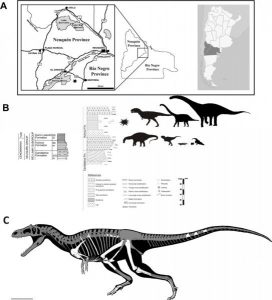
The discovery of a theropod dinosaur with Tyrannosaurus rex-like arms suggests that these unusual forelimbs may have evolved multiple times, according to a study published July 13, 2016 in the open-access journal PLOS ONE by Sebastián Apesteguía from the Universidad Maimónides, Argentina, and colleagues.
The Patagonian region of Argentina has previously proven to be rich in fossils from the Late Cretaceous epoch, which can teach us about the dinosaurs living there in this period. The authors of the present study examined a new Late Cretaceous dinosaur skeleton from the Huincul Formation in northern Patagonia and conducted phylogenetic analysis to determine its evolutionary history.
The dinosaur, which they named Gualicho shinyae, is a new theropod species which likely forms a sister taxon to the African dinosaur Deltadromeus. Although the skeleton was incomplete, the authors estimate that the dinosaur was likely a medium-sized slender predator weighing around a half ton, comparable to a polar bear. The analyzed skeleton shares many anatomical similarities with Deltadromeus. However, despite its overall size, the forelimbs were comparable in size to that of a human child’s, and the claws had just two digits (thumb and forefinger). These unusual arms are much more similar to those of the distantly related Tyrannosaurus rex (T. rex) than more closely-related species and may indicate that the forelimbs evolved independently on two branches of the evolutionary tree, rather than arising from a common short-armed ancestor.
Co-author Peter Makovicky notes: “Gualicho is kind of a mosaic dinosaur, it has features that you normally see in different kinds of theropods,” says corresponding author Peter Makovicky, The Field Museum’s Curator of Dinosaurs. “It’s really unusual — it’s different from the other carnivorous dinosaurs found in the same rock formation, and it doesn’t fit neatly into any category.”
It is not known why dinosaurs such as G. shinyae and T. rex had such disproportionately small forearms. Whilst this newly discovered dinosaur does not solve the mystery, it adds to evidence that the trait may have evolved independently numerous times. “By learning more about how reduced forelimbs evolved, we may be able to figure out why they evolved,” explains Peter Makovicky.
Reference:
Sebastián Apesteguía, Nathan D. Smith, Rubén Juárez Valieri, Peter J. Makovicky. An Unusual New Theropod with a Didactyl Manus from the Upper Cretaceous of Patagonia, Argentina. PLOS ONE, 2016; 11 (7): e0157793 DOI: 10.1371/journal.pone.0157793
Note: The above post is reprinted from materials provided by PLOS.










